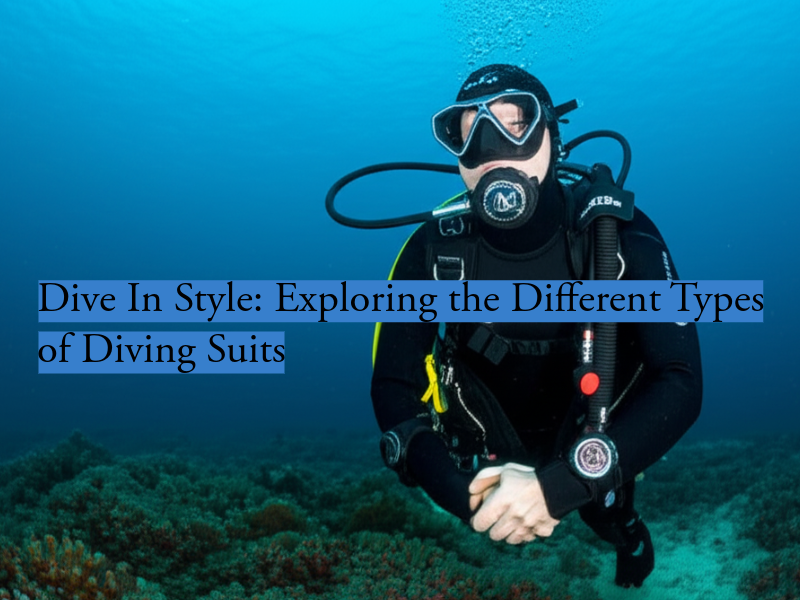
Dive In Style: Exploring the Different Types of Diving Suits
Share

Diving into the depths of the ocean or even a murky lake requires not just skill and courage, but also the right gear. And when it comes to staying warm, safe, and comfortable underwater, your diving suit is your best friend. But did you know there's more than one type of diving suit? Each is designed for specific conditions and diving activities.
Let's take a splash and explore the fascinating world of diving suits!
- Wetsuits: The Most Common Choice
If you've ever thought about diving, chances are the wetsuit is the first image that comes to mind. Wetsuits are designed to keep you warm by trapping a thin layer of water between your body and the suit. Your body then heats this trapped water, creating an insulating barrier.
Key Features:
* Material: Typically made from neoprene, a synthetic rubber that offers excellent insulation and flexibility.
* Thickness: Wetsuits come in various thicknesses (e.g., 3mm, 5mm, 7mm). Thicker suits provide more warmth and are suitable for colder water.
* Fit: A snug fit is crucial for a wetsuit to work effectively. Too loose, and water will flush in and out, reducing insulation.
* Uses: Ideal for recreational diving, snorkeling, surfing, and other watersports in temperate to warm waters.
Pros:
* More flexible and comfortable for movement.
* Generally less expensive than drysuits.
* Easier to don and doff (put on and take off).
Cons:
* Only suitable for waters where the temperature is not extremely cold.
* You will still get wet, which can be uncomfortable in colder conditions.
2. Drysuits: Staying Bone Dry in Chilly Waters
When the water gets seriously cold – think icy Arctic dives or even just temperate waters in winter – the wetsuit won't cut it. That's where the drysuit comes in. As the name suggests, a drysuit is designed to keep you completely dry by creating a watertight seal around your body.
Key Features:
* Material: Can be made from various materials, including compressed neoprene, trilaminate (a thin, durable fabric with layers of butyl rubber), or crushed neoprene.
* Seals: Features watertight seals at the neck and wrists to prevent water entry.
* Undergarments: Divers wear insulating layers (like fleece or thermal underwear) underneath the drysuit to provide warmth.
* Valves: Equipped with inflation and exhaust valves to add or remove air, helping with buoyancy control and preventing "squeeze" as you descend.
* Uses: Essential for diving in very cold water, technical diving, and prolonged dives where comfort and warmth are paramount.
Pros:
* Keeps you completely dry and warm, even in freezing water.
* Offers excellent thermal protection for extended dives.
* Can wear regular clothes underneath for added comfort and warmth.
Cons:
* More expensive than wetsuits.
* Requires specialized training for proper use, especially buoyancy control.
* Less flexible than wetsuits due to their bulkier construction.
* Maintenance, including seal care, is more involved.
3. Semi-Dry Suits: The Best of Both Worlds?
A semi-dry suit attempts to bridge the gap between wetsuits and drysuits, offering enhanced thermal protection compared to a standard wetsuit without the full complexity of a drysuit.
Key Features:
* Material: Usually thicker neoprene than wetsuits, often 7mm.
* Seals: Features better seals at the neck, wrists, and ankles than a wetsuit, often with zippers or glideskin material to minimize water flushing.
* Uses: Good for colder temperate waters where a wetsuit might be insufficient but a drysuit is overkill, or for divers transitioning to colder environments.
Pros:
* Offers better insulation than a wetsuit.
* More flexible and less bulky than a drysuit.
* Generally less expensive than a drysuit.
Cons:
* You still get wet, just less so than in a standard wetsuit.
* Not suitable for extremely cold conditions where a drysuit is necessary.
* Can be a bit of a compromise in terms of both flexibility and warmth.
4. Hot Water Suits: For the Extremes
While less common for recreational divers, hot water suits are crucial for commercial and professional divers working in extremely cold or hazardous environments, such as saturation diving or deep-sea oil rig work.
Key Features:
* Continuous Hot Water Supply: A hot water umbilical from the surface continuously pumps heated water into the suit, which then flushes out through various openings.
* Material: Typically made from a heavy-duty neoprene or similar material.
* Uses: Commercial diving, offshore oil and gas industry, salvage operations, and other demanding professional diving scenarios.
Pros:
* Provides unparalleled warmth in the coldest conditions.
* Essential for prolonged dives at extreme depths.
Cons:
* Requires a complex surface support system.
* Not practical or necessary for recreational diving.
* Very expensive and specialized.
Choosing Your Perfect Suit
The best diving suit for you ultimately depends on a few key factors:
* Water Temperature: This is the most critical factor.
* Type of Diving: Recreational, technical, commercial, etc.
* Your Comfort Level: Some divers tolerate cold better than others.
* Budget: Prices vary significantly between suit types.
No matter which suit you choose, remember that proper fit and maintenance are essential for safety and enjoyment underwater. So, research, try on different options, and get ready to explore the incredible underwater world in comfort and style!
